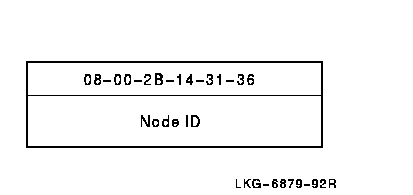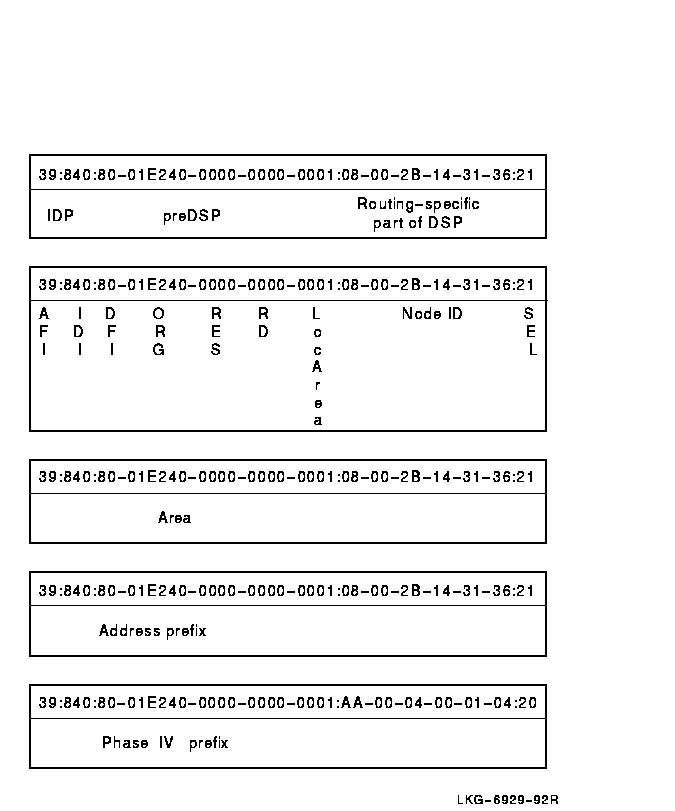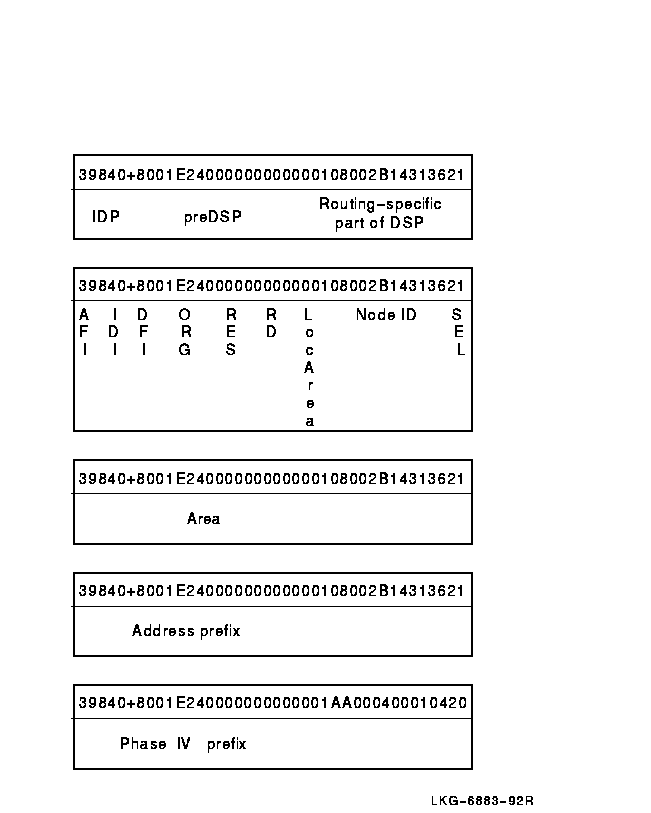HP OpenVMS Systems Documentation |
DECnet-Plus
|
| Previous | Contents | Index |
To convert a Phase IV address to an NSAP, you encode the Phase IV address into the local area and node ID fields of the NSAP. Fill in all the other NSAP fields in the normal manner.
To encode a Phase IV address into these fields, take the following steps:
For example, with:
then create the NSAP as follows:
IDP and selector = 41:45436192:local-area:node-id:20 43 decimal = 2B hexadecimal (local area) (43 * 1024) + 258 = 44290 decimal 44290 decimal = AD02 hexadecimal AD02 swapped = 02AD hexadecimal (node ID) |
The resulting NSAP is 41:45436192:00-2B:AA-00-04-00-02-AD:20.
4.5 Converting NSAPs to Phase IV Addresses
To convert an NSAP to a Phase IV address, reverse the process described in the previous section.
You get the Phase IV area by converting the local area field from hexadecimal to decimal. If the resulting area value does not fall in the range of 1 to 63 inclusive, the NSAP is an extended address.
Calculate the Phase IV node ID from the node ID field as follows:
area = value / 1024 id = value - (area * 1024) |
For example, with NSAP 37:81076541234:00-19:AA-00-04-00-62-64:21, calculate the Phase IV address by:
19 hexadecimal (from local area) = 25 decimal 62-64 (from node ID) = 6462 hexadecimal 6462 hexadecimal = 25698 decimal 25698/1024 = area of 25 25698 - (25 * 1024) = id of 98 |
The resulting Phase IV address is 25.98.
4.6 Forms of the NSAP Displayed by NCL
Some NCL commands accept and display NETs, area addresses, node IDs, or address prefixes. These values are subsets of a node's full NSAP. This section defines these values and shows how the example NSAP in Figure 4-2 is divided into these values.
Figure 4-2 Example NSAP

The network entity title (NET) is the same as the NSAP, with a selector field of 00. It identifies a node when the specific transport protocol to be used is either unknown or irrelevant. Figure 4-3 illustrates an NET.
Figure 4-3 Example NET

Area Address
An area address consists of the IDP, preDSP, and the local area fields of the NSAP. It identifies a level 2 routing area. Figure 4-4 illustrates an area address.
Figure 4-4 Example Area Address

Node ID
Consists of the node ID field of the NSAP. Identifies a particular node within a level 2 routing area.

Address Prefix
Consists of some leading portion of the NSAP, and can be of any length from zero digits up to the full length of the NSAP. Can be used in a reachable-address table to indicate that packets with a destination NSAP beginning with a specified address prefix are to be routed through a specified circuit.

Phase IV Prefix
Consists of all values up to (but not including) the local area field. Includes the AFI, IDI, and, if used, the preDSP. This value is used by DECnet-Plus when converting between Phase IV addresses and NSAPs.

If your network is to be interconnected with other networks, its NSAP must have a unique IDP and, possibly preDSP, to differentiate it from all other networks. For a unique IDP (and preDSP), you can contact an allocation authority, or you can create your own according to the guidelines in the following sections.
The following sections describe where to obtain an IDI (and preDSP) for
a specific AFI.
4.7.1 For a Private Network (AFI 49)
If your network will not be interconnected with other OSI networks, you
do not need a unique IDP. Use the AFI 49 with no IDI.
4.7.2 Allocation Authority for Single-Country Organizations (AFI 39)
The IDI value is assigned directly for each country by an authorized registration agent, according to ISO Standard 3166. The registration authority agent in the United States is the American National Standards Institute (ANSI), with offices in New York City.
In this case, the resulting IDP is entered as given by the allocation
authority. This IDP might also require the allocation of a value to be
placed in the preDSP.
4.7.3 Allocation Authority for International Organizations (AFI 47)
The IDI value is assigned directly for each international organization by an authorized registration agent, according to ISO Standard 6523-ICD.
In this case, the resulting IDP is entered as given by the allocation
authority. This IDP might also require the allocation of a value to be
placed in the preDSP.
4.7.4 Using an X.25 Data Network Address for the IDI (AFIs 37 and 53)
The IDI value is based on CCITT Recommendation X.121 and is created from a public or private data network address. The parts of this IDI are:
Company's subnetwork address prefix (DNIC and PNIC) = 8107654 Address within company's subnetwork = 1234 |
Resulting IDP value = 37:81076541234:
4.7.5 Using a Telex Number for the IDI (AFIs 41 and 55)
The IDI value is based on CCITT Recommendation F.69 and is created from
a Telex number that has been assigned to your company or organization.
The parts of this IDI are:
Example:
Destination code (for Switzerland) = 45 Local Telex number = 43 61 92 |
Resulting IDP value = 41:45436192:
4.7.6 Using a Telephone Number for the IDI (AFIs 43 and 57)
The IDI value is based on CCITT Recommendation E.163 and is created from a public switched telephone network (PSTN) number that has been assigned to your company or organization. The parts of this IDI are:
Consult your local PSTN for the world zone and the country numbers.
Choose one telephone number and use it to create a unique IDI value for your network. This number serves simply as a unique number that has been assigned to you.
Example:
World zone number (for U.S.A.) = 1 Geographic area number (for Massachusetts) = 508 Local number = 555-1192 |
Resulting IDP value = 43:15085551192:
4.7.7 Using an ISDN Number for the IDI (AFIs 45 and 59)
The IDI value is based on CCITT Recommendation E.164 and is created from an integrated services digital network (ISDN) number that has been assigned to your organization. ISDN is a technology offered by the telephone carriers of the world that combines voice and digital network services in one media, allowing for digital data services through a single "wire." The standards that define ISDN are specified by CCITT.
The parts of this IDI are:
The NDC and SN, which together make up the national significant number, are administered within each country, usually by the PTT.
Choose one ISDN number and use it to create a unique IDI value for your network. This number serves simply as a unique number that has been assigned to you.
Example:
Country code (for U.S.A.) = 1 National destination code (for New York) = 212 Subscriber number = 555-6172 |
Resulting IDP value = 45:12125556172
4.8 Example: NSAP Fields
This section shows examples of how an ANSI-formatted NSAP is divided into its component fields. For all examples, except for the one that shows a Phase IV prefix, the fields have the following values:
| Field | Value |
|---|---|
| AFI | 39 |
| IDI | 840 |
| DFI | 80 |
| ORG | 01E240 |
| RES | 0000 |
| RD | 0000 |
| LocArea | 0001 |
| Node ID | 08002B143136 |
| SEL | 21 |
The example showing the Phase IV prefix uses node ID and SEL values that are Phase IV-compatible, and these fields have the following values:
| Field | Value |
|---|---|
| NodeID | AA0004000104 |
| SEL | 20 |
Figure 4-5 shows the example NSAP using DNA format.
Figure 4-5 NSAP Fields: DNA Format Examples

Figure 4-6 shows the same examples using OSI format.
Figure 4-6 NSAP Fields: OSI Format Examples

This section applies to users in the United States who have applied to ANSI for a unique network identifier in the ISO DCC format. With values assigned by ANSI, an NSAP has the following DNA format:
AFI:IDI:DFI-ORG-RES-RD-LocArea:NodeID:SEL
Table 4-2 explains the NSAP fields used in this format.
| Field | Value | Meaning |
|---|---|---|
| AFI | 39 |
ANSI provides a decimal value.
Enter as two decimal digits. |
| IDI | 840 |
ANSI provides a decimal value.
Enter as three decimal digits. |
| DFI | 128 |
ANSI provides a decimal value.
Enter as two hexadecimal digits. |
| ORG | dddddd |
ANSI provides a decimal value.
Enter as six hexadecimal digits. |
| RES | 0000 |
Value reserved by ANSI for future use.
Enter as four zeros. |
| RD | dddd | Enter as four hexadecimal digits. |
| LocArea | dddd | Enter as four hexadecimal digits. |
| Node ID | dddddddddddd | Enter as 12 hexadecimal digits. |
| SEL | dd | Enter as two hexadecimal digits. |
All values supplied by ANSI are decimal numbers. Use the AFI and IDI in
your NSAP as decimal values. However, due to the encoding rules of
binary syntax NSAPs, you must convert the DFI and ORG values to
hexadecimal. You can easily convert these two values from decimal to
hexadecimal using a calculator or using the operating system's
calculator feature.

Use the DIGITAL UNIX bc command. For example, with an ORG value of 123456, use the following commands to convert the values:
# bc obase=16 /* Set the output radix to base 16 (hex) */ 128 /* Enter the decimal DFI value */ 80 /* Resulting hex value */ 123456 /* Enter the decimal ORG value */ 1E240 /* Resulting hex value */ <> |

Use an OpenVMS symbol. For example, with an ORG value of 123456, use the following commands to convert the values:
$dfi = 128 $org=123456 $sh sym dfi DFI = 128 Hex = 00000080 Octal = 00000000200 $sh sym org ORG = 123456 Hex = 0001E240 Octal = 00000361100 $ <> |
Using these values, the resulting NSAP has the following DNA NSAP format:
39:840:80-01E240-0000-RD-LocArea:NodeID:SEL |
While this section discusses NSAP values from ANSI, the same information also applies to other Phase V addressing values, including the NET, Phase IV prefix, and address prefixes. In addition, this information is based on the draft ANSI standard:
"Data Communications --- Structure and Semantics of the Domain Specific Part (DSP) of the OSI Network Service Access Point (NSAP) Address"
ANSI might review and modify this standard.
| Previous | Next | Contents | Index |